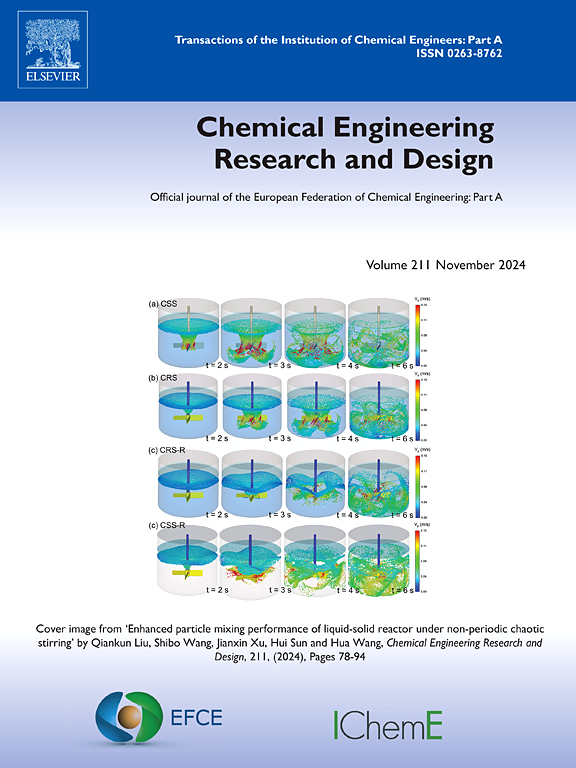设计和控制用于分离 THF/IPA/ 水的热集成 EDWC 工艺
IF 3.7
3区 工程技术
Q2 ENGINEERING, CHEMICAL
引用次数: 0
摘要
萃取分壁柱(EDWC)和热集成是分离共沸物的有效工艺强化策略。在本研究中,系统地研究了结合使用萃取分馏塔(EDWC)和热集成与中间再沸器分离四氢呋喃/异丙醇/水的稳态和动态控制。通过相图分析混合物的热力学特性,评估了萃取蒸馏工艺的可行性,并将三塔萃取蒸馏(TCED)工艺确立为基本工艺。为了提高能源效率和经济效益以及环境可持续性,提出了三种改进工艺。与 TCED 相比,最佳工艺(E-EDWC-HI2)的年总成本、能耗和二氧化碳排放量分别降低了 22.35%、41.77% 和 26.28%。此外,还为 E-EDWC-HI2 提出了一种动态控制结构,该结构对进料流速和成分的干扰具有鲁棒性。这项研究为复杂蒸馏过程的设计和动态控制提供了指导。本文章由计算机程序翻译,如有差异,请以英文原文为准。
The design and control of heat-integrated EDWC processes for the separation of THF/IPA/water
Extractive dividing wall columns (EDWC) and heat integration are effective process intensification strategies for separating azeotropes. In this study, the steady-state and dynamic control for the separation of tetrahydrofuran/isopropanol/water using a combination of EDWC and heat integration with intermediate reboilers are systematically investigated. The feasibility of the extractive distillation process is evaluated by analyzing the thermodynamic characteristics of the mixture through phase diagrams, and the three-column extractive distillation (TCED) process is established as the basic process. To enhance the energy and economic efficiencies, as well as environmental sustainability, three improved processes are proposed. Compared with TCED, the optimal process (E-EDWC-HI2) reduces the total annual costs, energy consumption, and CO2 emissions by 22.35 %, 41.77 %, and 26.28 %, respectively. In addition, a dynamic control structure is proposed for the E-EDWC-HI2, which exhibits robustness against disturbances in the feed flow rate and composition. This study provides guidance for the design and dynamic control of complex distillation processes.
求助全文
通过发布文献求助,成功后即可免费获取论文全文。
去求助
来源期刊

Chemical Engineering Research & Design
工程技术-工程:化工
CiteScore
6.10
自引率
7.70%
发文量
623
审稿时长
42 days
期刊介绍:
ChERD aims to be the principal international journal for publication of high quality, original papers in chemical engineering.
Papers showing how research results can be used in chemical engineering design, and accounts of experimental or theoretical research work bringing new perspectives to established principles, highlighting unsolved problems or indicating directions for future research, are particularly welcome. Contributions that deal with new developments in plant or processes and that can be given quantitative expression are encouraged. The journal is especially interested in papers that extend the boundaries of traditional chemical engineering.
 求助内容:
求助内容: 应助结果提醒方式:
应助结果提醒方式:


